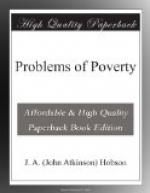Probably a large majority of women-workers are to some extent bounty-fed in one of these ways. In so far as they do receive assistance from one of these sources, enabling them to accept lower wages than they could otherwise have done, it should be clearly understood that they are presenting the difference between the commercial and the uncommercial price as a free gift to their employer, or in so far as competition will oblige him to lower his prices, to the public, which purchases the results of their work. But the most terrible effect of this uncommercial competition falls on that miserable minority of their sisters who have no such extra source of income, and who have to make the lower wages find clothes, and shelter for themselves, and perhaps a family of children. We hear a good deal about the jealousy of men, and the difficulties male Trade Unions have sometimes thrown in the way of women obtaining employment, which may seem to affect male interests. But though there is doubtless some ground for these complaints, it should be acknowledged that it is women who are the real enemies of women. Women’s wages in the “sweating” trades are almost incredibly low, because there is an artificially large supply of women able and willing to take work at these low rates.
It will be possible to raise the wages in these low-paid employments only on condition that women will agree to refuse to undersell one another beyond a certain point. A restriction in what is called “freedom of competition” is the only direct remedy which can be applied by women themselves. If women could be induced to refuse to avail themselves of the terrible power conferred by these different forms of “bounty,” their wages could not fall below that 9s. or 10s. which would be required to keep them alive, and would probably rise higher.
Sec. 8. What Trade Unionism can do for them.—A question which naturally rises now is, how far combination in the form of Trade Unionism can assist to raise the industrial condition of these women. The practical power wielded by male Unions we saw was twofold. Firstly, by restricting the supply of labour in their respective trades they raised its market price, i.e. wages. Secondly, they could extract better conditions from employers, by obliging the latter to deal with them as a single large body instead of dealing with them as a number of individuals. How far can women-workers effect these same ends by these same means?
Trade Unionism, so far as women are concerned, is yet in its infancy. In 1874, Mrs. Paterson established a society, now named the Women’s Trades Union Provident League, to try and establish combination among women in their several trades. The first Union was that of women engaged in book-binding, formed in September 1874. Since then a considerable number of Unions have been formed among match-makers, dressmakers, milliners, mantle-makers, upholstresses, rope-makers, confectioners, box-makers, shirt-makers,




